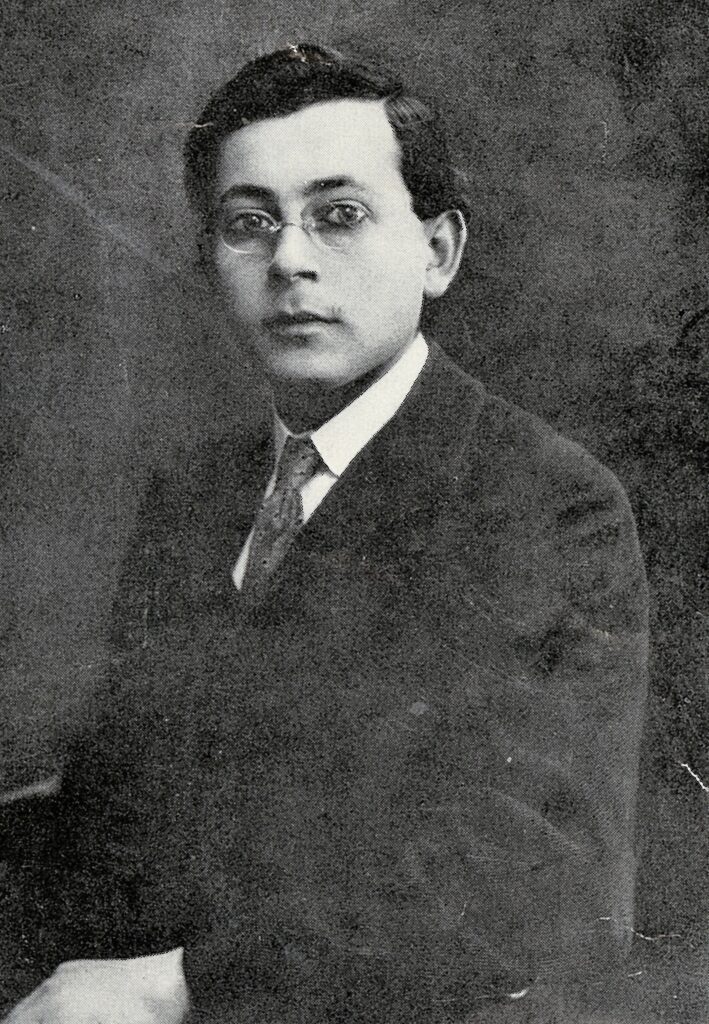Podcast Episode | The Writings of a Wandering Poet

Release date: 28 November 2024 | More about the Podcast Series For the Living and the Dead: Traces of the Holocaust
In this podcast episode, we learn about a remarkable manuscript that survived the Holocaust and was later discovered to be the work of one of the most interesting modern creators of Hebrew literature in the 20th century: David Vogel. The manuscript is made up of pages upon pages of miniscule, uniform handwriting and was hidden by Vogel in the back garden of the boarding house in Hauteville, France where he was staying before his arrest by the Gestapo in 1944. Vogel was murdered in Auschwitz concentration camp at the age of 52, but his writings and the story of his life live on to inspire, inform and commemorate the turbulent 1930s in Europe.

Image Courtesy of Gnazim Archives.
Vogel was born in Staniv in the Podolia region in 1891, then in the Russian empire and today in Ukraine. He moved to Vilnius, where he attended yeshiva, and then in 1912 to Vienna – the center of literature and culture during the Fin de siècle. At the beginning of the First World War Vogel was imprisoned in Vienna – and not for the last time in his short life – as he was considered a subject of an enemy country; Russia. He met and married Ada Nadler, with whom he had one daughter, Tamara. In 1925 they moved to Paris, the city of lights that beckoned him and the literary and artistic people of its time.
We are joined in this episode by Amir Ben-Amram, archivist at The Gnazim Institute of the Hebrew Writers Association, the largest Hebrew literature archive in the world, who will talk us through the fascinating journey behind this discovery. From the manuscript’s burial in Hauteville, France, we follow its voyage across Europe and the sea to America, passing through the hands of Vogel’s close friend, and painter, Avraham Goldberg, to Shimon Halkin, writer and poet and finally to Asher Barash, chairman of the Hebrew Writers’ Association and founder of the Gnazim Archive, where it found its final resting place. The manuscript is now part of the collection of The Gnazim Institute of the Hebrew Writers Association.
Featured guests:
Amir Ben-Amram is an archivist at the Gnazim Institute of the Hebrew Writers Association. Podcast host is Katharina Freise.
Listen to the episode on Buzzsprout,Spotify, Apple Podcasts, Podcast Addict or here:
More on this episode:
Discovering the “Viennese Novel”
It wasn’t until some seventy years after Vogel was murdered in Auschwitz that the final piece of his work was discovered. Years after his works arrived at the Gnazim archive, young researcher Lilach Nethanel was reviewing it and happened across some pages filled with tiny writing. Speaking of the discovery, Nethanel states: “The bunch of sheets that lay in bulk on my desk at the time included, apart from the early and partial draft of the novella ‘In front of the sea’, another, unknown manuscript… Sometime later, with the completion of the decipherment and arrangement of all fifteen sheets that make up the work from beginning to end, I recognized that this is an early novel that Vogel wrote in dense and tiny writing and then buried it among other manuscripts – possibly shelved it, possibly kept it for further processing at a future time that was shy of coming.” This unknown manuscript, discovered by chance, was published under the title “Viennese novel” in 2013.

Image Courtesy of Gnazim Archives.
Tracing David Vogel’s Travels
Vogel’s life was characterized by restlessness; a never-ending search for belonging and a home amongst like-minded thinkers and intellects of the times. His travels throughout the 1920s and 30s took him across Europe and beyond then back again on a fateful journey through some of the most socio-culturally and politically turbulent cities of the time.
In 1925, Vogel moved to Paris, drawn in by the booming literary and artistic movement taking place there. It was here that he met his second wife, Ada Nadler, and by the end of the decade they were married and had a daughter, Tamara.
Around this time, a new intellectual center was emerging in the Land of Israel. Many authors and poets such as Chaim Nachman Bialik, Asher Barash, Avraham Shlonsky and many others worked here in those years, and they established the Association of Hebrew Writers. The association invited Vogel to immigrate to Israel, which he did with his young family in 1929.

Image Courtesy of Gnazim Archives.
Restless and unhappy in the social and cultural climate in Isreal, Vogel and his family returned to Europe in 1930, sailing out of the port of Jaffa and arriving five days later in Trieste, Italy.
From there, the family travelled through Yugoslavia, Poland, Austria and Germany, settling for a time in Berlin. Vogel did not find rest nor success there, and the family continued traveling between the cultural Jewish centers where Vogel hoped to find fame and livelihood, without luck.
Vogel returned to France in 1932, where the family remained, living at first in Paris before fleeing to the Southeast with the outbreak of the Second World War. In 1944, he was arrested by the Gestapo, imprisoned in Lyon, and sent to Drancy, a transit camp for French Jews. Four days later, he was murdered in Auschwitz. Ada was able to survive the war due to her internment at a sanitorium in Hauteville. Tamara, was kept by a (non-Jewish) foster family, survived the war and after her mother’s death, emigrated to the USA.
Other Wandering Writers of the Period
Vogel was not the only creator who felt rooted in Europe and longed to stay there – one might mention Gershon Shofman, who lived in an Austrian village and for years refused to immigrate to Palestine. Only at the last moment, when the ground was burning under his feet with Nazi Germany’s takeover of Austria, did he give in to the pleas of his friends and immigrate to Israel. Another European Jew, the writer and historian Shimon Dubnov, also hesitated to flee and immigrate to Palestine when the winds of war began to blow in Europe, and when he was finally convinced to do so – it was too late to save him.
France in WW2 from the EHRI Portal
France was invaded by the German army in May 1940, fell in June, and signed an armistice a few weeks later. General de Gaulle, established a government-in-exile in London, Free France, which joined the Allies and supported the Resistance. According to the armistice, Germany annexed the provinces of Alsace and Lorraine, while the rest of France was divided into a small demilitarized Italian zone in the south east and two large parts: the Occupied Zone and the Free Zone. The first encapsulated Northern France and the Atlantic Coast and was placed under German military control. Southern France remained unoccupied and was placed under the control of a new French government, headed by Marshal Philippe Pétain. In response to the Allied landings in North Africa in November 1942, German and Italian forces also occupied the Southern Zone. When Italy attempted to surrender to the Allies in September 1943, the Germans took over the Italian zone of France. The liberation of France began with the Allied landings in Normandy on 6 June 1944. Two months later, on 25 August, the German forces in Paris surrendered.
In the summer of 1940, France had a total population of 40,690,000 inhabitants. Some 300,000 to 350,000 were Jewish, with 145,000 living in the Southern Zone. About half of the Jewish population were not French citizens, but Jews who had moved to France after the First World War or had arrived as Jewish refugees during the 1930s. Almost immediately after the occupation, Jews in both zones were subjected to a first wave of anti-Jewish measures. In the German-controlled zone, Jews were removed from their jobs, their freedom of movement was restricted, and many were arrested. At the same time, the Vichy government actively commenced persecuting Jews. In October 1940, it passed a set of anti-Jewish laws called the Statut des Juifs (Jewish Statute). In March 1941, the Vichy authorities set up a General Commissariat for Jewish Affairs (Commissariat Général aux Questions Juives). In June 1942, the Germans forced the Jews in the occupied zone to wear the Jewish badge for easy identification, began arresting large groups, and restricted the movements of the remaining community. The “round-ups” (rafles) were carried out with the full cooperation of the French police during the operation Vent Printanier in summer 1942. The most notable was the roundup of the Vélodrôme d’Hiver or Vél d’Hiv in Paris, organized and executed solely by the French police. There, about 13,000 Jews (men, women and children) were rounded up, and some 7,000 of them were jammed into the Vél d’Hiv in deplorable conditions. Many thousands of Jews were arrested and sent to transit camps, mostly to Drancy, Compiègne and Pithiviers, from where they were deported to Nazi-occupied Poland. The Vichy authorities also arrested and deported approximately 7,000 Jews from their zone in the summer of 1942. Altogether, 42,500 Jews were sent to Nazi-occupied Poland during 1942. Nearly one third of them came from unoccupied France. German authorities resumed transports of Jews from France in January 1943 and continued the deportations until August 1944. In total, approximately 80,000 Jews were deported from France. Some 70,000 were sent to Auschwitz, while the others were sent to Majdanek, Sobibor and, in smaller numbers, to Buchenwald. Among the deportees, only 2,000 survived. Others died in detention on French soil.
Note: The former French colonies are discussed in country reports under their present-day name.
Learn More
- Vienna in WW2 on the EHRI Portal
- The Gnazim Institute of the Hebrew Writers Association
- David Vogel on Wikipedia
- Gershom Shofman
- Simon Dubnow
Credits
Our thanks go to:
- Amir Ben-Amram
- The Gnazim Archives for rights to use images of the manuscript
- Lilach Nethanel for speaking about her discovery of the lost manuscript.
- Our first EHRI intern Anthonia Prins for helping develop this remarkable story into a script
- Music accreditation: Blue Dot Sessions. Tracks – Opening and closing: Stillness. Incidental, Gathering Stasis, Pencil Marks, Uncertain Ground, Marble Transit and Snowmelt. License Creative Commons Attribution-NonCommercial 4.0 International (BB BY-NC 4.0).
- Andy Clark, Podcastmaker, Studio Lijn 14
